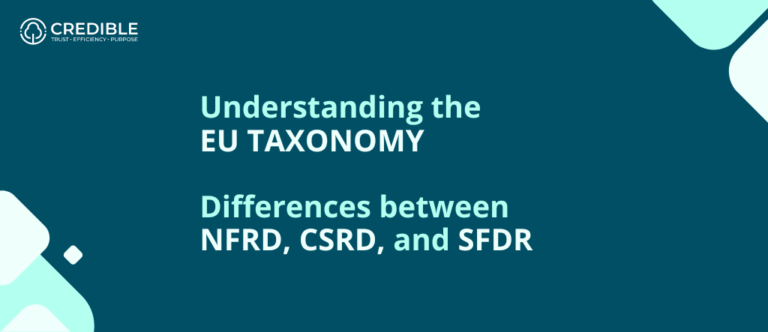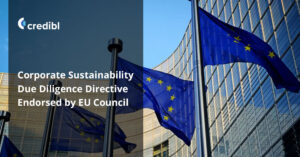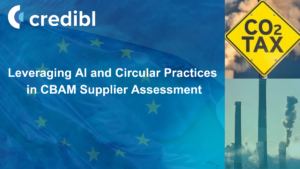The EU Taxonomy is a classification system that aims to establish a common language for sustainable economic activities in the European Union. It helps investors, companies, and policymakers understand which economic activities are sustainable and contribute to achieving the EU’s climate and environmental objectives. The EU Taxonomy is essential for promoting sustainable finance and facilitating the transition to a low-carbon and resource-efficient economy.
The European Union has introduced several regulations to enforce these changes to ensure that companies provide accurate and comparable ESG information. These regulations include the Corporate Sustainability Reporting Directive (CSRD), the Sustainable Finance Disclosure Regulation (SFDR), and the Non-Financial Reporting Directive (NFRD).
For companies, it is important to understand the differences between these regulations and how they impact reporting requirements. Fund managers and investors must also be aware of each regulation’s reporting requirements to make informed investment decisions.
| Directive | Scope | Key Requirements |
NFRD |
Large public-interest entities with more than 500 employees | Report on policies, risks, outcomes, and key performance indicators related to ESG issues |
CSRD |
All large companies, regardless of legal form | Mandatory sustainability reporting, digital reporting system |
SFDR |
Asset managers and financial advisers marketing financial products as sustainable | Disclosure of ESG integration in investment decisions, information about the sustainability impact of investments |
Non-Financial Reporting Directive (NFRD)
The Non-Financial Reporting Directive (NFRD) was introduced in 2014 and is designed to improve the transparency and accountability of large EU companies regarding their non-financial performance. The directive requires companies to report on a range of non-financial matters, including environmental, social, and governance (ESG) factors. The aim is to provide investors and other stakeholders with more reliable and comparable information on a company’s ESG performance, which can help them make better-informed decisions.
Under the NFRD, companies are required to provide a non-financial statement, which should include a description of their policies, risks, and outcomes regarding ESG matters. This statement should be included in the company’s annual report, which must be made publicly available on the company’s website. The statement should also be audited by an independent auditor or subject to some form of external verification.
Corporate Sustainability Reporting Directive (CSRD)
The Corporate Sustainability Reporting Directive (CSRD) is a proposed amendment to the existing NFRD. The CSRD aims to enhance the quality, comparability, and credibility of corporate sustainability reporting by introducing new reporting requirements and standards.
The CSRD proposes several key changes and updates to the existing NFRD. Firstly, the directive expands the scope of sustainability reporting by requiring companies to report on additional topics, such as human rights, supply chain due diligence, and biodiversity. Secondly, it introduces new reporting standards that will be developed by the European Financial Reporting Advisory Group (EFRAG) in collaboration with the European Commission. These standards will be mandatory for companies to use, ensuring comparability and consistency in reporting. Thirdly, the CSRD introduces requirements for digital reporting, which will improve the accessibility and availability of sustainability information.
Companies that must comply with the directive, will need to improve the quality and comparability of their sustainability reporting to meet the new standards, which can help them to identify ESG risks and opportunities in their operations. For fund managers, the more detailed and standardized reporting required under the CSRD can help them to make better-informed investment decisions and to identify ESG risks and opportunities in their investment portfolios.
Sustainable Finance Disclosure Regulation (SFDR)
The Sustainable Finance Disclosure Regulation (SFDR) is a new regulation that came into effect in March 2021. It is designed to promote sustainable investments by requiring asset managers and financial advisers to disclose information about their investments’ environmental and social impact.
The SFDR provides greater transparency and accountability in the financial sector, by requiring financial market participants to disclose information on the sustainability impact of their investments. This can help consumers make more informed decisions about where they invest their money, based on their values and beliefs. For companies that must comply with the SFDR, the regulation provides a framework for integrating sustainability risks and opportunities into their investment decision-making processes, which can help them to identify ESG risks and opportunities in their operations. For fund managers, the SFDR provides a standardized approach to disclosing the sustainability impact of their investments, which can help them to make better-informed investment decisions and to identify ESG risks and opportunities in their investment portfolios.
Comparison of NFRD, CSRD, and SFDR
While all three directives aim to promote sustainability and ESG reporting in the financial sector, there are some key differences between them. The NFRD focuses on non-financial reporting, requiring companies to disclose information on a range of ESG topics, such as environmental impact, social issues, and anti-corruption measures. The CSRD builds on the NFRD, expanding the scope of reporting and introducing new requirements, such as reporting on ESG risks and opportunities. The SFDR focuses on financial market participants, requiring them to disclose information on how they integrate sustainability risks and opportunities into their investment decisions and provide information on their investments’ sustainability impact.
| Non-Financial Reporting Directive (NFRD) | Corporate Sustainability Reporting Directive (CSRD) | Sustainable Finance Disclosure Regulation (SFDR) | |
| Scope | Applicable to large public-interest entities with more than 500 employees | Applicable to all large companies operating in the EU | Applicable to all financial market participants and advisors operating in the EU |
| Disclosure Requirements |
|
|
|
| Timeline | Currently in force, but will be replaced by the CSRD | Will be applicable starting from January 1, 2023 | Applicable since March 10, 2021 |
| Goals | Increase transparency and comparability of sustainability reporting among companies | Improve quality and consistency of sustainability reporting among companies | Foster sustainability in the financial sector by requiring more transparency on sustainability issues |
| Reporting Standards | Member States have flexibility in choosing reporting standards but EU non-binding guidelines are available | Will be based on EU sustainability reporting standards, which will be developed in the future | Will be based on EU taxonomy and standards for sustainable investments |
| Sanctions for Non-Compliance | Non-compliant companies may face fines or legal action from stakeholders | Non-compliant companies may face fines or legal action from stakeholders | Non-compliant companies may face fines or loss of authorization for financial market participants and advisors |
| Complementarity | Can be used in combination with the SFDR and CSRD to provide a more comprehensive sustainability reporting framework for companies | Complements the NFRD and SFDR by providing more detailed requirements for sustainability reporting among companies | Can be used in combination with the NFRD and CSRD to provide a more comprehensive sustainability reporting framework for financial market participants and advisors |
As companies and fund managers navigate these regulatory frameworks, it is important to understand the differences between the NFRD, CSRD, and SFDR. While they share similar objectives, each directive has unique requirements and disclosures that companies and fund managers must comply with. By understanding these regulations and their reporting requirements, companies can improve their ESG performance and investors can make more informed investment decisions.
In conclusion, The EU is committed to achieving its climate and sustainability goals, and ESG reporting plays a crucial role in this process. As the global shift towards sustainable finance continues to grow, ESG reporting standards will likely become even more rigorous and demanding.







